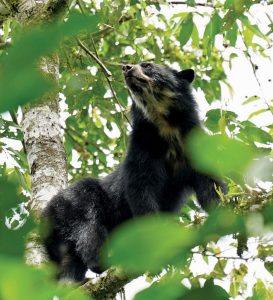
November 2017
Table of Contents
Recovery from Disaster Catalyzes Positive Change
As a tropical ecologist, I never anticipated I’d be coordinating humanitarian aid after the Ecuador earthquake of 2016, and I had many lessons to learn. Among them: Relief is the easy part. In the face of tragedy, the world opens its heart with aid, and with good coordination, communities can be stabilized in just a few weeks.
Recovery is the long, expensive, and arduous process of building back infrastructure and restarting the shattered economy. I found that disaster presents an opportunity to re-envision communities and “build back better,” avoiding the mistakes of the past. I also learned there is no clear end-point to recovery, it is simply a more urgent version of the sustainable development work we’ve been doing all along. In fact, with sufficient resources and good leadership, the one naturally transitions to the other. The inspiring outpouring of support made it possible for Ceiba to lead an outstanding relief and recovery effort that brought the community together around a vision of a more sustainable future. Tabuga, Camarones, and other villages on the coast are in the process of building back better: improving livelihoods not despite protecting the environment and conserving biodiversity, but because of it.
In 2018 I am energized by the opportunities for positive change on Ecuador’s coast: protecting and connecting unique forests, promoting environmentally-friendly shade coffee, continuing research aimed at conserving coastal wildlife, and working with community members towards a brighter “eco-future” for the region and its people. (Catherine Woodward, President)

RELIEF AND RECOVERY FUND SUMMARY 2016-2017
We thank the 734 generous donors who gave an inspiring $100,782 to the earthquake fund. The majority was spent on: local labor for reconstruction and coordination; food, medicine, and household goods; temporary shelters and rebuilding materials; and risk assessment and training in safe building practices. The remainder was largely dedicated to stimulus for area farmers, a coffee-growing cooperative, and textile and soap-making microenterprises. Not included here are grants totaling $87,000 for rubble removal, economic reactivation, and ecotourism training.

Expenditures from Earthquake Relief Fund, 2016-2017
Producing Science, and Food, at Lalo Loor
Research on the unique ecology of tropical dry forests on Ecuador’s coast is urgently needed to inform conservation and management decisions, as land-uses change and deforestation pressures intensify. At the Lalo Loor Dry Forest field station our studies include assessing the impacts of the Pacific Highway on wildlife, tracking Howler Monkey population trends, and monitoring stream water quality. Visiting scientists have investigated bat diversity and aquatic macroinvertebrates, both under-studied groups. Recent surveys found species new to the reserve: the Western Round-eared Bat (Lophostoma occidentalis), and Berthold’s Bush Anole (Polychrus gutturosus).
This year we also planted an agroforestry demonstration plot, working with local students. Agroforestry – production of food crops under trees – is a useful conservation tool, enhancing local food production while mimicking forest habitat. By monitoring soil quality, crop yield, and animal diversity, we can show local producers the economic and environmental benefits of the plot. And we are providing organic food to the reserve, consuming locally and reducing our ecological footprint. Thus far, only 10 months after planting, we have harvested over 40 pounds of pigeon pea (Cajanus cajan) that are being devoured by our staff and visitors! (LF)

Berthold’s Bush Anole, photographed at Lalo Loor
Linking Forests in the Jama Conservation Corridor
Ceiba staff have updated our map of the Jama Conservation Corridor, a plan to conserve 31,000 hectares (75,000 acres) of threatened coastal forest remnants. We are working hand-in-hand with the REDD+ group in Ecuador, a component of the Kyoto international climate change agreement that involves the World Bank and the Ecuadorian Ministry of Environment. They have secured US$24 million to promote creation of biological corridors, protected areas, and bio-commerce that improves local livelihoods through sustainable development. Ceiba is urging the REDD+ group to allocate funds to Jama and Pedernales, two counties where we work, for purchase of priority sites by the local municipality. Our current objective is to identify critical forests that maintain connectivity within the corridor, secure their protection, and build local capacity for their monitoring and management. Biological corridors are now seen as a crucial adaptation strategy for global climate change, as they enable plants and animals to move in response to changing conditions. You can get involved as a volunteer and help us map some of these priority sites! (CT)

Corridor forest patches (yellow) and protected sites (green)
Healthy Environment, Healthy People
As Ecuador approaches the two year anniversary of the devastating earthquake, the Ceiba Foundation continues to lead projects that promote linkages between healthy environments and thriving communities. For years we have studied the water quality of streams that serve rural communities near the Lalo Loor Dry Forest Reserve. When communicating our results to local residents, we underscore the need to protect forests from which clean waters emerge, and the health benefits of safe drinking water. Now Ceiba is working closely with landowners to promote environmentally friendly agriculture like shade coffee (photo). With our help, cooperatives have formed to establish treeand-coffee plantations that support a high diversity of native wildlife, and provide valuable overwinter habitat for migratory birds. Cooperative members earn more money, and require less cleared land, growing coffee than raising cattle, and the streams that emerge from these plantations are far cleaner and healthier than from pastures. (JM)

New Chocó-Andino Biosphere Reserve Includes El Pahuma
The Pahuma Orchid Reserve, protected by Ceiba since 1999, is part of a new Biosphere Reserve protecting 200,000 hectares (500,000 acres). The reserve links lowland Chocó forests in the northwest to the high Andes mountains, regions distinguished by extraordinary biodiversity and high endemism. The reserve encompasses El Pahuma and numerous other protected sites, including several internationally recognized Important Bird Areas (IBAs). Surveys have identified over 540 species of birds in the region, 139 species of amphibians and reptiles, as well as 111 species of mammals including the emblematic Spectacled Bear, now endangered in Ecuador. New species are being discovered regularly, such as the Olinguito (Bassaricyon neblina), an arboreal marsupial discovered in 2013, and the Pristimantis pahuma frog found in the forests of El Pahuma by Ceiba alum Carl Hutter. The new Biosphere Reserve will be implemented in 2018, and will be a crucial tool in ongoing battles against proposed mining operations that would not only damage one of Earth’s most biodiverse areas, but harm local operators of sustainable ecotourism like El Pahuma’s Lima family. (CT)

Former Ceiba Student Ascends to New Heights
I am a 2010 alumna of Ceiba’s Tropical Conservation Semester, currently studying the impacts of climate change on North American birds for the US Forest Service in the Sierra Nevada Mountains of California. Since graduating from UW-Madison I have worked across the United States and abroad as an ecologist and conservation biologist. I’ve documented arboreal amphibians in Madagascar, tracked endangered birds in New Zealand, collected pollen and seeds from waterfall dwelling plants, and monitored sharks and marine mammals off the coast of California. For three years I worked as an avian ecologist and AmeriCorps intern in Hawaii, studying endangered honey-creeper birds and helping to start one of the state’s largest reforestation projects. The Hawaiian Islands are in the midst of an extinction crisis: over 97% of the state’s endemic flora and fauna are listed as endangered and many species critically threatened by climate change and disease. In 2018, I plan to pursue Ph.D. research on avian malaria, the greatest threat to Hawaiian birds, with the hope of stemming rates of avian extinction. I credit my study abroad experience with Ceiba as quintessential to my career, reawakening a childhood passion for science and providing me with the research and critical thinking skills to work anywhere in the world. Education programs like Ceiba’s are indispensable for training and inspiring young scientists to tackle the world’s greatest environmental challenges. (Christa Seidl)

Ceiba has offered highly impactful, university-accredited education programs since 1999. This year we launch two new summer courses. Coral Reef Ecology will be taught in Belize, home of the world’s largest barrier reef system outside of Australia. The other “new kid at school” will be Conservation GIS, that links geographic information systems and digital mapping with real-world conservation problem-solving. Students will learn to collect GPS data in the field, produce maps, and analyze spatial data, while contributing to local conservation organizations and communities. Check out our Education section for all our educational opportunities! (JM)
Message from Executive Director Carolina Toapanta
Since 2016 I have been the Executive Director of Ceiba projects in Ecuadorme to grow professiond personally. Serving people in times of need while promoting conservation of their natural resources has changed my life. I am very happy to report on some of our progress. In February 2017, we partnered with World Wildlife Fund to offer a workshop in Green Recovery Reconstruction Methodologies to rural communities in Jama County (Manabí Province): 47 community leaders acquired valuable training in sustainable building techniques. In June we obtained funds from the United Nations Development Programme to reactivate a program of micro-entrepreneurship in villages near the Lalo Loor reserve (see Relief and Recovery Summary 2016-2017). Thanks to this program, artisan craft makers, clothing designers, ecotourism operators, and others have increased their income by 70%. With donor funds we built a Health Center in the community of Tabuga, supplied equipment to a new restaurant and bakery in the village, and recently inaugurating the Tabuga Community Center. Lastly we were able to construct, through a partnership with Fundación Coopera, two classrooms for Tabuga’s elementary school, continuing Ceiba’s long-standing commitment to rural education. I want to thank all our donors for making these projects possible: I know this progress would not have happened without your support, and I am pleased to say that our success in Ecuador is something we have all done together! (CT)

Carolina informs REDD+ team on recovery challenges in Manabí Province
Volunteers Lend Skills, Energy, and Enthusiasm
This year our dedicated volunteers and interns have supported numerous projects based at the Lalo Loor Dry Forest Reserve. They contributed to teacher training in environmental education, and to marketing and business planning for sustainable community development. Others have been an integral part of establishing and maintaining the reserve’s agroforestry plot (see page 3), and contributing to our ongoing research on dry forest dynamics. Ceiba’s wildlife monitoring projects are in high gear as we expand our research sites to include areas surrounding the reserve, and learn more about animal movements through different types of habitat. Our results help protect threatened wildlife for visitors to enjoy. (YR)

Planting trees for wildlife, bananas for humans
Join Us in Making a Difference
We live in challenging times. Amidst much uncertainty it can be easy to lose hope, but we see examples every day of how regular, hard working people can make a positive difference. Ceiba is offering communities in Ecuador the chance to choose paths to development that go hand-in-hand with conservation. But poverty and lack of educational opportunity can force people into decisions that cause further harm. With your help we will provide communities the resources they need to pursue a more sustainable future. Please join others who have made Ceiba a top-rated nonprofit, and make your gift today.

Why support Ceiba? Because you believe that …
• successful conservation is rooted in local communities
• protecting the most biodiverse places impacts us all
What can you do?
• make a gift to Ceiba … online, by check, or wire transfer
• join us as a volunteer, student, or visitor